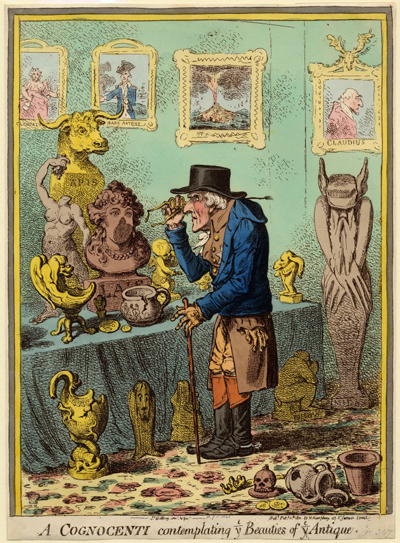A Cognocenti...
A Cognocenti Contemplating ye Beauties of ye Antique is essentially a portrait caricature of Sir William Hamilton (1730-1803), that becomes firecely satiric as a result of our reading of the objects surrounding him.
Sir William Hamilton was a diplomat and archaeologist. From 1764 until 1800, shortly before this print appeared, he served as the British Envoy to Naples. It was during his long residence in Naples and later Palermo that he became a notable collector of paintings and antiquities, including an extensive set of Greek, Etruscan, and Roman vases which were later sold to the British Museum. He also published several treatises on volcanoes based on observations of Vesuvius and Etna and, as a result, was elected a Fellow of the Royal Society. He later become a member of both the Society of Antiquaries and the Society of Dilettanti.
But though he was well-known and respected for his knowledge of antiquities, it is not for that reason that Hamilton became a subject of Gillray's interest. It is rather because of Hamilton's second wife, the charming and beautiful Emma Hart, 35 years his junior, who in 1798 began a long-term affair with Horatio, Lord Nelson, the hero of the Battle of the Nile and later of the Battle of Trafalgar.

© Trustees of the British Museum
So in Gillray's print, Sir William is appropriately surrounded by supposed paintings and antiquities but nearly all of them allude to the affair of Emma and Lord Nelson. On the wall, for instance, there are paintings labeled Cleopatra and Mark Antony, the two tragic lovers of Roman history and Shakespeare's play, but clearly depicting Emma and Lord Nelson eyeing one another with unrestrained interest. The two pictures are visually linked by their two hands reaching towards one another and by the strategically placed horns of Apis, the bull-deity, sometimes associated with fertility. It is not unlikely that Gillray was aware that Lady Hamilton had just given birth to a daughter by Nelson about two weeks before the publication of this print.
On the far right is a painting framed with cuckhold's horns, labeled Claudius after the Roman emperor whose wife, Messalina was notoriously unfaithful to him. But once again the image is clearly that of a somewhat pained Sir William looking away from the activities of the couple, much as he did in real life. Beneath the picture of Claudius is a statue of King Midas with the ass's ears paralleling the cuckhold's horns, looking very much ashamed. To the left is a last picture, an image of a volcano erupting, which could refer to Sir William, but is more likely an expression of the explosive affair of Emma and Lord Nelson which continued to be a national scandal, even after Nelson's death. (Emma was forbidden to attend the funeral).
On the table in front of Sir William are a number of antiquities which continue the allusions. One is a statue of Lais, a courtesan in ancient Greece, who bears some resemblance to the wide eyed portrait of Emma as Circe (1782) by George Romney. Beside it is a headless bacchantae, whose pose, again, bears some resemblance of another painting by Romney of Emma as a Bacchante. A similar pose was used by Emma in one of her famous "attitudes" which Gillray parodied in 1807. In front of Lais is a bowl, significantly cracked, with a picture of the three graces. Beside it, a Cupid gazes sadly in the direction of Sir William, with a drooping arrow held pathetically in front of him.
Sources and Reading
- Commentary from the British Museum on A Cognocenti...
- Draper Hill, The Satirical Etchings of James Gillray, 1976, #71
- "Horatio Nelson, 1st Viscount Nelson," Wikipedia
- "Emma, Lady Hamilton," Wikipedia
- "William Hamilton (diplomat)," Wikipedia
- Thomas Wright and R.H. Evans, Historical and Descriptive Account of the Caricatures of James Gillray #498
Comments & Corrections
NOTE: Comments and/or corrections are always appreciated. To make that easier, I have included a form below that you can use. I promise never to share any of the info provided without your express permission.